Kim Jong-un
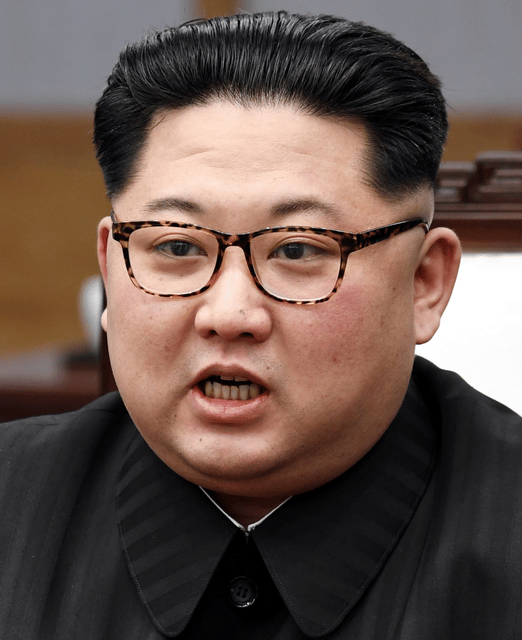
Kim Jong-un

| 3rdSupreme Leader of North Korea | |
|---|---|
| 17 December 2011 | |
| President | Kim Yong-namChoe Ryong-hae |
| Premier | Choe Yong-rimPak Pong-juKim Jae-ryong |
| Kim Jong-il | |
| Chairman of the Workers' Party of Korea | |
| 9 May 2016 | |
| Deputy | |
| Himselfas First Secretary | |
| Chairman of the State Affairs Commission | |
| 29 June 2016 | |
| Deputy | Choe Ryong-hae |
| First Secretary of the Workers' Party of Korea | |
| 11 April 2012 – 9 May 2016 | |
| Deputy | |
| Kim Jong-ilas General Secretary | |
| Himselfas Chairman | |
| First Chairman of theNational Defence Commission | |
| 13 April 2012 – 29 June 2016 | |
| Deputy | Kim Yong-chunRi Yong-muJang Song-thaekO Kuk-ryolChoe Ryong-haeHwang Pyong-so |
| Kim Jong-ilas Chairman | |
| Himselfas Chairman of the State Affairs Commission | |
| Commander-in-Chief of the Armed Forces of the Democratic People's Republic of Korea | |
| 30 December 2011 | |
| Kim Jong-il | |
| Personal details | |
| Born | 8 January 1983 (South Koreanrecords)[2]8 January 1984 (American records)[3][4]Pyongyang,North Korea |
| Nationality | North Korean |
| Political party | Workers' Party of Korea |
| Spouse(s) | |
| Children | Kim Ju-aeand possibly another two |
| Parents | Kim Jong-ilKo Yong-hui |
| Alma mater | Kim Il-sung UniversityKim Il-sung Military University |
| Signature | |
| Military service | |
| Allegiance | North Korea |
| Branch/service | Korean People's Army |
| Years of service | 2010–present |
| Rank | Marshal of the Republic |
| Commands | Commander-in-Chief |
| Kim Jong-unorKim Jong Un | |
| Korean name | |
| Chosŏn'gŭl | |
| Hancha | |
| Revised Romanization | Gim Jeong(-)eun |
| McCune–Reischauer | Kim Chŏngŭn |
Kim Jong-un (officially transcribed Kim Jong Un; Korean: 김정은; Korean pronunciation: [kim.dzɔŋ.ɯn];[1] born 8 January 1983 or 1984) is a North Korean politician. He is the incumbent Supreme Leader of North Korea since 2011 and Chairman of the Workers' Party of Korea since 2012. He is the second child of Kim Jong-il (1941–2011), the country's second leader from 1994 to 2011, and Ko Yong-hui (1952–2004).[6] He is the grandson of Kim Il-sung, who was the founder and first leader of North Korea from 1948 to 1994.[7] Kim is the first North Korean leader who was born after the country's founding, and is also the third youngest currently-serving head of government in the world.
From late 2010, Kim Jong-un was viewed as heir apparent to the leadership of the DPRK, and following the elder Kim's death, North Korean state television announced him as the "Great Successor".[8] Kim holds the titles of Chairman of the Workers' Party of Korea (as First Secretary between 2012 and 2016), Chairman of the Central Military Commission, Chairman of the State Affairs Commission, commander-in-chief (as SAC chairman),[9] and member of the Presidium of the Politburo of the Workers' Party of Korea, the highest decision-making body in North Korea.[10] Kim was promoted to the rank of Marshal of North Korea in the Korean People's Army on 18 July 2012, consolidating his position as the Supreme Commander of the Armed Forces.[11] North Korean state media often refers to him as Marshal Kim Jong-un, "the Marshal"[12] or "Dear Respected."[13]
Forbes magazine ranked Kim as the 46th most powerful person in the world in 2013 and the third highest amongst Koreans after Ban Ki-moon and Lee Kun-hee.[14] On 12 December 2013, Kim ordered the execution of his uncle Jang Song-thaek for "treachery".[15] Kim is widely believed to have ordered the assassination of his half-brother, Kim Jong-nam, in Malaysia in February 2017.[16][17]
In 2018, Kim Jong-un and South Korean President Moon Jae-in met twice in Panmunjom on the border between North and South, and once in Pyongyang. On 12 June 2018, Kim and US President Donald Trump met for a summit in Singapore, the first-ever talks held between a North Korean leader and a sitting US President, to discuss the North Korean nuclear program. A follow-up meeting in Hanoi in February 2019 ended abruptly without an agreement. On 25 April 2019, Kim and Russian President Vladimir Putin held their first summit in Vladivostok, Russia.[18] On 30 June 2019, Kim met with both South Korean President Moon Jae-in and Trump at the Korean Demilitarized Zone.
| 3rdSupreme Leader of North Korea | |
|---|---|
| 17 December 2011 | |
| President | Kim Yong-namChoe Ryong-hae |
| Premier | Choe Yong-rimPak Pong-juKim Jae-ryong |
| Kim Jong-il | |
| Chairman of the Workers' Party of Korea | |
| 9 May 2016 | |
| Deputy | |
| Himselfas First Secretary | |
| Chairman of the State Affairs Commission | |
| 29 June 2016 | |
| Deputy | Choe Ryong-hae |
| First Secretary of the Workers' Party of Korea | |
| 11 April 2012 – 9 May 2016 | |
| Deputy | |
| Kim Jong-ilas General Secretary | |
| Himselfas Chairman | |
| First Chairman of theNational Defence Commission | |
| 13 April 2012 – 29 June 2016 | |
| Deputy | Kim Yong-chunRi Yong-muJang Song-thaekO Kuk-ryolChoe Ryong-haeHwang Pyong-so |
| Kim Jong-ilas Chairman | |
| Himselfas Chairman of the State Affairs Commission | |
| Commander-in-Chief of the Armed Forces of the Democratic People's Republic of Korea | |
| 30 December 2011 | |
| Kim Jong-il | |
| Personal details | |
| Born | 8 January 1983 (South Koreanrecords)[2]8 January 1984 (American records)[3][4]Pyongyang,North Korea |
| Nationality | North Korean |
| Political party | Workers' Party of Korea |
| Spouse(s) | |
| Children | Kim Ju-aeand possibly another two |
| Parents | Kim Jong-ilKo Yong-hui |
| Alma mater | Kim Il-sung UniversityKim Il-sung Military University |
| Signature | |
| Military service | |
| Allegiance | North Korea |
| Branch/service | Korean People's Army |
| Years of service | 2010–present |
| Rank | Marshal of the Republic |
| Commands | Commander-in-Chief |
| Kim Jong-unorKim Jong Un | |
| Korean name | |
| Chosŏn'gŭl | |
| Hancha | |
| Revised Romanization | Gim Jeong(-)eun |
| McCune–Reischauer | Kim Chŏngŭn |
Early life
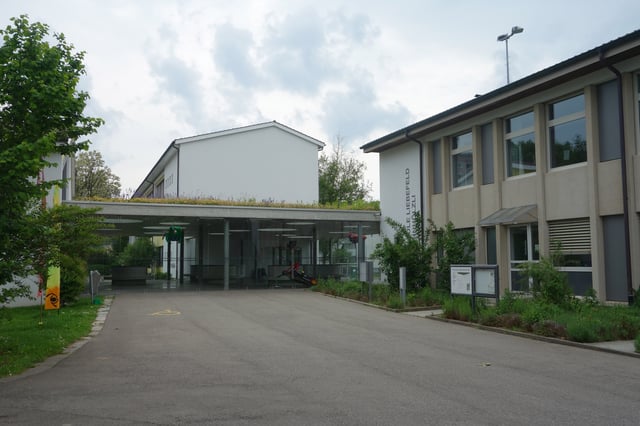
The Liebefeld-Steinhölzli public school in Köniz, Switzerland, which Kim Jong-un is reported to have attended
North Korean authorities and state-run media have stated that Kim's birthdate was 8 January 1982,[19] but South Korean intelligence officials believe the actual date is a year later.[2] It is thought that Kim's official birth year was changed for symbolic reasons; 1982 marks 70 years after the birth of his grandfather, Kim Il-sung, and 40 years after the official birth of his father Kim Jong-il. The US Treasury Department lists Kim Jong-un's official birthdate as 8 January 1984.[20] Former basketball star Dennis Rodman confirmed that 8 January was Kim Jong-un's birthdate after meeting in September 2013 in North Korea, and that Kim was 30 years of age at the time.[2]
All the children of Kim Jong-il are said to have lived in Switzerland, as well as the mother of the two youngest sons, who lived in Geneva for some time.[23] First reports said that Kim Jong-un attended the private English-language International School in Gümligen in Switzerland under the name "Chol-pak" or "Pak-chol" from 1993 to 1998.[24] He was described as shy, a good student who got along well with his classmates and was a basketball fan.[25] He was chaperoned by an older student, who was thought to be his bodyguard.[26] However, it was later suggested that the student at the Gümligen was not Kim Jong-un, but his elder brother Kim Jong-chul.[27]
Later, it was reported that Kim Jong-un attended the Liebefeld Steinhölzli state school in Köniz near Bern under the name "Pak-un" or "Un-pak" from 1998 until 2000 as the son of an employee of the North Korean embassy in Bern. Authorities confirmed that a North Korean student from North Korea attended the school from 1998 to 2000. Pak-un first attended a special class for foreign-language children and later attended the regular classes of the 6th, 7th, 8th, and part of the final 9th year, leaving the school abruptly in the autumn of 2000. He was described as a well-integrated and ambitious student who liked to play basketball.[28] However, his grades and attendance rating are reported to have been poor.[29] The ambassador of North Korea in Switzerland, Ri Chol, had a close relationship with him and acted as a mentor.[23] One of Pak-un's classmates told reporters that he had told him that he was the son of the leader of North Korea.[30][31] According to some reports, Kim was described by classmates as a shy child who was awkward with girls and indifferent to political issues, but who distinguished himself in sports and had a fascination with the American National Basketball Association and Michael Jordan. One friend claimed that he had been shown pictures of Pak-un with Kobe Bryant and Toni Kukoč.[32]
In April 2012, new documents came to light indicating that Kim Jong-un had lived in Switzerland since 1991 or 1992, earlier than previously thought.[33]
The Laboratory of Anatomic Anthropology at the University of Lyon, France, compared the picture of Pak-un taken at the Liebefeld Steinhölzli school in 1999 with a picture of Kim Jong-un from 2012 and concluded that the faces show a conformity of 95%, suggesting that it is most likely that they are the same person.[34]
The Washington Post reported in 2009 that Kim Jong-un's school friends recalled he "spent hours doing meticulous pencil drawings of Chicago Bulls superstar Michael Jordan".[35] He was obsessed with basketball and computer games.[32][36]
In late February 2018, Reuters reported that Kim and his father had used forged passports—supposedly issued by Brazil and dated 26 February 1996—to apply for visas in various countries. Both 10-year passports carry a stamp saying "Embassy of Brazil in Prague". Kim Jong-un's passport records the name "Josef Pwag" and a date of birth of 1 February 1983.[40]
For many years, only one confirmed photograph of him was known to exist outside North Korea, apparently taken in the mid-1990s, when he was eleven.[41] Occasionally other supposed images of him surfaced but were often disputed.[42] It was only in June 2010, shortly before he was given official posts and publicly introduced to the North Korean people, that more pictures were released of Kim, taken when he was attending school in Switzerland.[43] The first official image of him as an adult was a group photograph released on 30 September 2010, at the end of the party conference that effectively anointed him, in which he is seated in the front row, two places from his father. This was followed by newsreel footage of him attending the conference.[44]
Succession
Pre-2010 Party Conference speculation
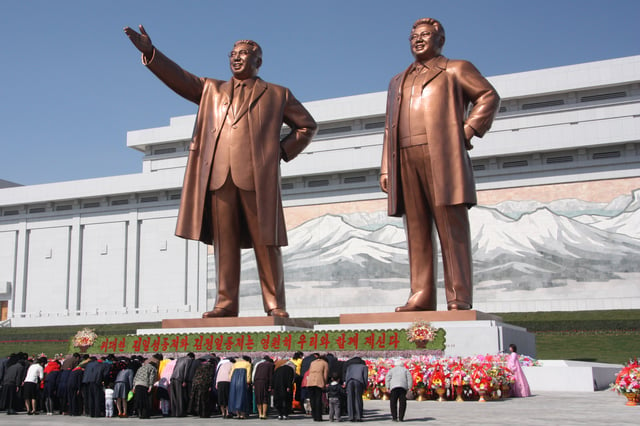
People paying homage[54] to the statues of Kim Il-sung and Kim Jong-il, April 2012
Kim Jong-un's eldest half-brother, Kim Jong-nam, had been the favorite to succeed, but reportedly fell out of favor after 2001, when he was caught attempting to enter Japan on a fake passport to visit Tokyo Disneyland.[45] Kim Jong-nam was killed in Malaysia in 2017 by suspected North Korean agents.[46]
Kim Jong-il's former personal chef, Kenji Fujimoto, revealed details regarding Kim Jong-un, with whom he had a good relationship,[47] stating that he was favored to be his father's successor. Fujimoto also said that Jong-un was favored by his father over his elder brother, Kim Jong-chul, reasoning that Jong-chul is too feminine in character, while Jong-un is "exactly like his father".[37] Furthermore, Fujimoto stated that "if power is to be handed over then Jong-un is the best for it. He has superb physical gifts, is a big drinker and never admits defeat." Also, according to Fujimoto, Jong-un smokes Yves Saint Laurent cigarettes, loves Johnnie Walker whisky and has a Mercedes-Benz 600 luxury sedan.[49] When Jong-un was 18, Fujimoto described an episode where Jong-un once questioned his lavish lifestyle and asked, "we are here, playing basketball, riding horses, riding jet skis, having fun together. But what of the lives of the average people?"[37] On 15 January 2009, the South Korean news agency Yonhap reported that Kim Jong-il had appointed Kim Jong-un to be his successor.[45][50]
On 8 March 2009, BBC News reported that Kim Jong-un was on the ballot for elections to the Supreme People's Assembly, the rubber stamp parliament of North Korea.[51] Subsequent reports indicated that his name did not appear on the list of lawmakers,[52] but he was later elevated to a mid-level position in the National Defense Commission, which is a branch of the North Korean military.[53]
From 2009, it was understood by foreign diplomatic services that Kim was to succeed his father Kim Jong-il as the head of the Korean Workers' Party and de facto leader of North Korea.[55] He has been named "Yŏngmyŏng-han Tongji" (영명한 동지), which loosely translates to "Brilliant Comrade".[56] His father had also asked embassy staff abroad to pledge loyalty to his son.[57] There have also been reports that citizens in North Korea were encouraged to sing a newly composed "song of praise" to Kim Jong-un, in a similar fashion to that of praise songs relating to Kim Jong-il and Kim Il-sung.[58] Later, in June, Kim was reported to have visited China secretly to "present himself" to the Chinese leadership, who later warned against North Korea conducting another nuclear test.[59] The Chinese foreign ministry has strongly denied that this visit occurred.[60]
In September 2009, it was reported that Kim Jong-il had secured support for the succession plan, after a propaganda campaign.[61] It is believed by some that Kim Jong-un was involved in the Cheonan sinking[62] and the bombardment of Yeonpyeong[63] to strengthen his military credentials and facilitate a successful transition of power from his father.[64]
Vice Chairman of the Central Military Commission
Kim Jong-un was made a daejang, the equivalent of a four-star general in the United States,[65] on 27 September 2010, a day ahead of a rare Workers' Party of Korea conference in Pyongyang, the first time North Korean media had mentioned him by name and despite him having no previous military experience.[66] Despite the promotion, no further details, including verifiable portraits of Kim, were released.[67] On 28 September 2010, he was named vice chairman of the Central Military Commission and appointed to the Central Committee of the Workers' Party, in an apparent nod to become the successor to Kim Jong-il.[68]
On 10 October 2010, Kim Jong-un was alongside his father when he attended the ruling Workers' Party's 65th-anniversary celebration.
This was seen as confirming his position as the next leader of the Workers' Party.
Unprecedented international press access was granted to the event, further indicating the importance of Kim Jong-un's presence.[69] In January 2011, the regime reportedly began purging around 200 protégés of both Jong-un's uncle-in-law Jang Song-thaek and O Kuk-ryol, the vice chairman of the National Defence Commission, by either detention or execution to further prevent either man from rivaling Jong-un.[70]
Leader of North Korea
Assuming official titles
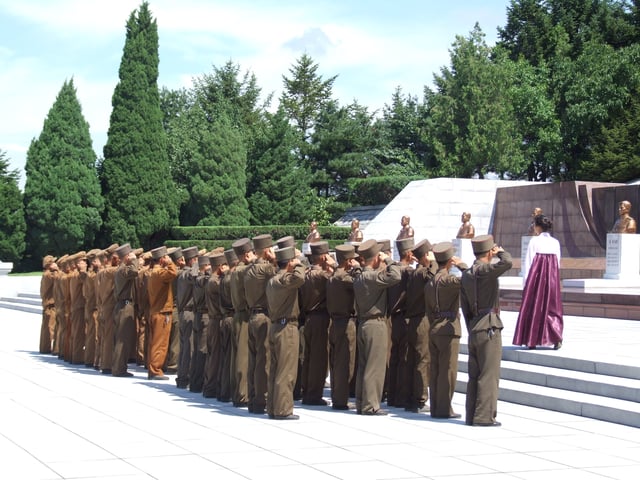
North Korean soldiers saluting at the Revolutionary Martyrs' Cemetery in Pyongyang, 2012
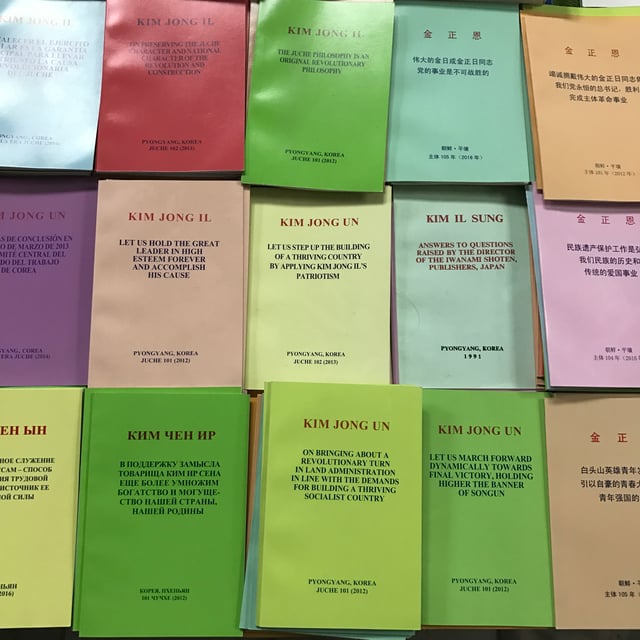
A selection of Kim Jong-un's works
On 17 December 2011, Kim Jong-il died.
Despite the elder Kim's plans, it was not immediately clear after his death whether Jong-un would in fact take full power, and what his exact role in a new government would be.[71] Some analysts had predicted that when Kim Jong-il died, Jang Song-thaek would act as regent, as Jong-un was too inexperienced to immediately lead the country.[72][73]
Following his father's death, Kim Jong-un was hailed as the "great successor to the revolutionary cause of Juche", "outstanding leader of the party, army and people"[74] and "respected comrade who is identical to Supreme Commander Kim Jong-il",[75] and was made chairman of the Kim Jong-il funeral committee. The Korean Central News Agency described Kim Jong-un as "a great person born of heaven", a propaganda term only his father and grandfather had enjoyed.[76] And the ruling Workers' Party said in an editorial, "We vow with bleeding tears to call Kim Jong-un our supreme commander, our leader."[77]
He was publicly declared Supreme Commander of the Korean People's Army on 24 December 2011[78] and formally appointed to the position on 30 December 2011 when the Political Bureau of the Central Committee of the Workers' Party "courteously proclaimed that the dear respected Kim Jong Un, vice-chairman of the Central Military Commission of the WPK, assumed the supreme commandership of the Korean People's Army".[9]
On 9 January 2012, a large rally was held by the Korean People's Army in front of the Kumsusan Palace of the Sun to honor Kim Jong-un and to demonstrate loyalty.[81]
On 27 March 2012, Kim was elected to the Fourth Conference of the Workers' Party of Korea.
On 11 April, that conference wrote the post of general secretary out of the party charter and instead designated Kim Jong-il as the party's "Eternal General Secretary".
The conference then elected Kim Jong-un as leader of the party under the newly created title of First Secretary.
Kim Jong-un also took his father's post as Chairman of the Central Military Commission, as well as his father's old seat on the Politburo Presidium.[82] In a speech made prior to the Conference, Kim Jong-un declared that "Imbuing the whole society with Kimilsungism-Kimjongilism is the highest programme of our Party".[83] On 13 April 2012, the 5th Session of the 12th Supreme People's Assembly appointed Kim Jong-un Chairman of the National Defence Commission.[84]
On 15 April 2012, during a military parade to commemorate Kim Il-sung's centenary, Kim Jong-un made his first public speech, Let Us March Forward Dynamically Towards Final Victory, Holding Higher the Banner of Songun.[85] That speech became the basis of a hymn dedicated to him, "Onwards Toward the Final Victory".[86]
In July 2012,[87] Kim Jong-un was promoted to wonsu (translated as marshal), the highest active rank in the military. The decision was jointly issued on by the Central Committee and the Central Military Commission of the Workers' Party of Korea, the National Defence Commission, and the Presidium of the Supreme People's Assembly, the Korean Central News Agency subsequently announced.[11] The only higher rank is Dae Wonsu (roughly translated as Grand Marshal or Generalissimo) which was held by Kim's grandfather, Kim Il-sung, and which was awarded posthumously to his father, Kim Jong-il, in February 2012.[11][87] The promotion confirmed Kim's role as top leader of the North Korean military and came days after the replacement of Chief of General Staff Ri Yong-ho by Hyon Yong-chol.[11]
In November 2012, satellite photos revealed a half-kilometer-long (1,600 ft) propaganda message carved into a hillside in Ryanggang Province, reading, "Long Live General Kim Jong-un, the Shining Sun!"[88]
Officially, Kim Jong-un is part of a triumvirate heading the executive branch of the North Korean government along with Premier Kim Jae-ryong (no relation) and parliament president Choe Ryong-hae. Each nominally holds powers equivalent to a third of a president's powers in most presidential systems. Kim Jong-un commands the armed forces, Kim Jae-ryong heads the government and handles domestic affairs, and Choe Ryong-hae handles foreign relations. Nevertheless, it is generally understood that Kim Jong-un, like his father and grandfather before him, exercises absolute control over the government and the country. Indeed, a constitutional amendment enacted by his father explicitly named the NDC (first) chairman as "the supreme leader of the Democratic People's Republic of North Korea".[89]
On 30 November 2012, Kim met with Li Jianguo, who "briefed Kim on the 18th National Congress of the Communist Party of China", according to the state's official news agency, the Korean Central News Agency.[90] A letter from Xi Jinping, General Secretary of the Communist Party of China, was hand-delivered during the discussion.[90]
On 9 March 2014, Kim Jong-un was elected to a seat in the Supreme People's Assembly, the country's unicameral legislature. He ran unopposed, but voters had the choice of voting yes or no. There was a record turnout of voters and, according to government officials, all voted "yes" in his home district of Mount Paekdu.[91] The Supreme People's Assembly subsequently elected him first chairman of the National Defense Commission.[92]
New leadership style
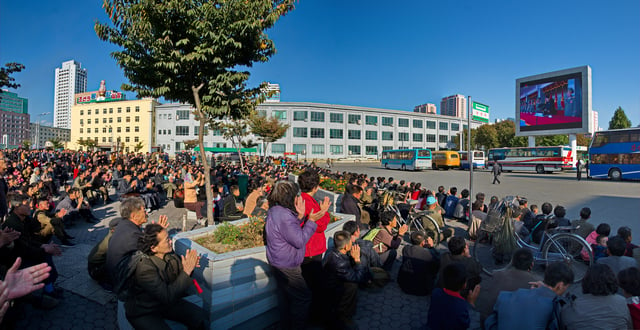
People in Pyongyang watch Kim Jong-un on North Korean TV, 2015
In July 2012, Kim Jong-un showed a change in cultural policy from his father by attending a Moranbong Band concert. The concert contained several elements of pop culture from the West, particularly the United States. Kim used this event to debut his wife to the public, an unprecedented move in North Korea.[93]
In 2012, Kim Jong-il's personal chef Kenji Fujimoto visited North Korea and said, "Stores in Pyongyang were brimming with products and people in the streets looked cheerful. North Korea has changed a lot since Kim Jong-un assumed power. All of this is because of leader Kim Jong-un."[94]
In 2013, Kim re-established his grandfather's style when he made his first New Year's address, a break from the approach of his father.
Kim Jong-il never made televised addresses during his 17 years in power.[95] In lieu of delivering a speech, Kim Jong-il contributed to and approved a New Year's Day editorial, jointly published by Rodong Sinmun (the daily newspaper of the Korean Workers' Party), Joson Inmingun (the newspaper of the Korean People's Army), and Chongnyon Jonwi (the newspaper of the Kimilsungist-Kimjongilist Youth League).[96]
In May 2014, following the collapse of an apartment building in Pyongyang, Kim Jong-un was said to be very upset at the loss of life that resulted.
A statement issued by the country's official news agency the Korean Central News Agency used the rare expression "profound consolation and apology". An unnamed government official was quoted by the BBC as saying Kim Jong-un had "sat up all night, feeling painful".[97] While the height of the building and the number of casualties was not released, media reports described it is a 23-story building and indicated that more than a hundred people may have died in the collapse.[98]
Economic policies
A set of comprehensive economic measures, the "Socialist Corporate Responsible Management System", were introduced in 2013.[99] The measures increase the autonomy of enterprises by granting them "certain rights to engage in business activities autonomously and elevate the will to labor through appropriately implementing the socialist distribution system".
Another priority of economic policies that year was agriculture, where the pojon (vegetable garden) responsibility system was implemented. The system reportedly achieved a major increase in output in some collective farms.[99] North Korean media were describing the economy as a "flexible collectivist system" where enterprises were applying "active and evolutionary actions" to achieve economic development.[100] These reports reflect Kim's general economic policy of reforming management, increasing the autonomy and incentives for economic actors.
This set of reforms known as the "May 30th measures" reaffirms both socialist ownership and "objective economic laws in guidance and management" to improve living standards.
Other objectives of the measures are to increase the availability of domestically manufactured goods on markets, introduction of defence innovations into the civilian sector and boost international trade.[100]
There has been a construction boom in Pyongyang, bringing colour and creative architectural styles to the city.
While in the past there was a concentration on building monuments, Kim Jong-un's government has constructed amusement parks, aquatic parks, skating rinks, a dolphinarium and a ski resort.[101][102]
Purges and executions
In December 2013, Kim Jong-un's uncle Jang Song-thaek was arrested and executed for treachery.[105] Jang is believed to have been executed by firing squad. Yonhap has stated that, according to multiple unnamed sources, Kim Jong-un has also put to death members of Jang's family, to completely destroy all traces of Jang's existence through "extensive executions" of his family, including the children and grandchildren of all close relatives. Those reportedly killed in Kim's purge include Jang's sister Jang Kye-sun, her husband and ambassador to Cuba, Jon Yong-jin, and Jang's nephew and ambassador to Malaysia, Jang Yong-chol. The nephew's two sons were also said to have been killed.[106] At the time of Jang's removal, it was announced that "the discovery and purge of the Jang group... made our party and revolutionary ranks purer..."[107] and after his execution on 12 December 2013 state media warned that the army "will never pardon all those who disobey the order of the Supreme Commander".[108]
O Sang-hon (Korean: 오상헌; RR: O Sangheon; MR: O Sanghŏn) was a deputy security minister in the Ministry of People's Security in the government of North Korea who was reportedly killed in a political purge in 2014. According to the South Korean newspaper The Chosun Ilbo, O was executed by flamethrower for his role in supporting Kim Jong-un's uncle Jang Song-taek.[109]
Human rights violations
The 2013 report on the situation of human rights in North Korea[110] by United Nations Special Rapporteur Marzuki Darusman proposed a United Nations commission of inquiry[111] to document the accountability of Kim Jong-un and other individuals in the North Korean government for alleged crimes against humanity.[112] The report of the commission of inquiry[113] was published in February 2014 and recommends making him accountable for crimes against humanity at the International Criminal Court.[114]
In July 2016, the United States Department of the Treasury imposed personal sanctions on Kim. Although his involvement in human rights abuses was cited as the reason,[115] officials said the sanctions target the country's nuclear and missile programs.[116]
In June 2017, President Trump condemned Kim Jong-un's "brutal" regime and described Kim as a "madman" after the death of American student Otto Warmbier who had been imprisoned during a visit to North Korea.[117] However, in 2019, U.S. President Trump said that he believed Kim was not responsible for Warmbier's death.[118]
Alleged 2017 CIA assassination attempt
In May 2017, the North Korean government stated that the Central Intelligence Agency (CIA) of the United States and the South Korean National Intelligence Service (NIS) hired a North Korean lumberjack who worked in Russia to assassinate Kim Jong-un with a "biochemical weapon" that was both radioactive and nano-poisonous, and whose effect would have been delayed by a few months.[119] North Korea said that it would seek extradition of anyone involved in the assassination attempt.[120]
Nuclear weapons development
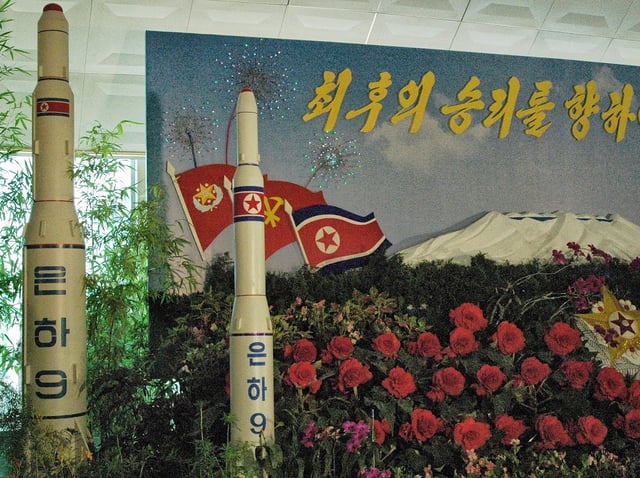
Model of a Unha-9 rocket on display at a floral exhibition in Pyongyang, 30 August 2013
Under Kim Jong-un, North Korea has continued to develop nuclear weapons, testing bombs in February 2013, January and September 2016, and September 2017, and conducting over 80 missile tests.[121] At a plenary meeting of the Central Committee of the Workers' Party held on 31 March 2013, Kim Jong-un announced that North Korea will adopt "a new strategic line on carrying out economic construction and building nuclear armed forces simultaneously".[122]
According to several analysts, North Korea sees the nuclear arsenal as vital to deter an attack, and it is unlikely that North Korea would launch a nuclear war.[123] According to a RAND Corporation senior researcher, Kim Jong-un believes that nuclear weapons are his guarantee of regime survival.[121]
During the 7th Congress of the Workers' Party of Korea in 2016, Kim Jong-un stated that North Korea would "not use nuclear weapons first unless aggressive hostile forces use nuclear weapons to invade on our sovereignty".[125] However, on other occasions, North Korea has threatened "pre-emptive" nuclear attacks against a US-led attack.[126] In December 2015, Kim stated that his family "turned the DPRK into a powerful nuclear weapons state ready to detonate a self-reliant A-bomb and H-bomb to reliably defend its sovereignty and the dignity of the nation".[127]
In January 2018, estimates of North Korea's nuclear arsenal ranged between 15 and 60 bombs, probably including hydrogen bombs. In the opinion of analysts, the Hwasong-15 missile is capable of striking anywhere in the United States.[121]
The United Nations enacted a series of sanctions against North Korea for its nuclear program and missile tests.[128]
Détente
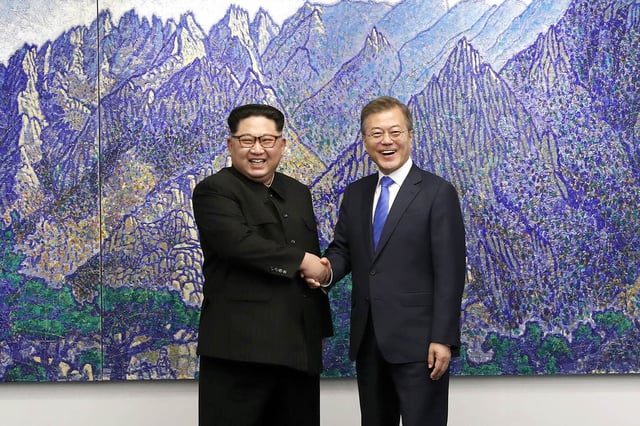
Kim and South Korean President Moon Jae-in shake hands during the 2018 inter-Korean Summit, April 2018
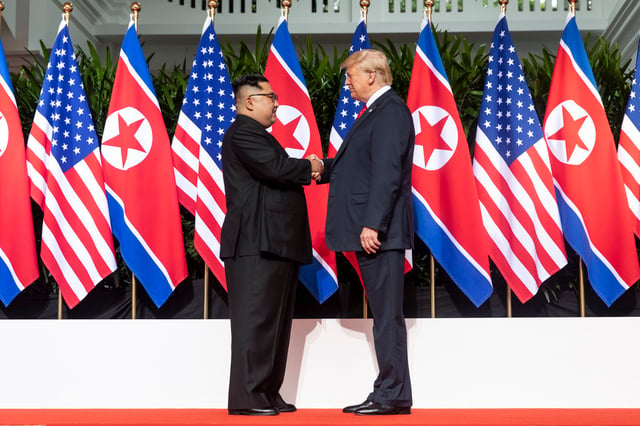
Kim and U.S. President Donald Trump shake hands at the start of the 2018 North Korea–United States Summit, June 2018
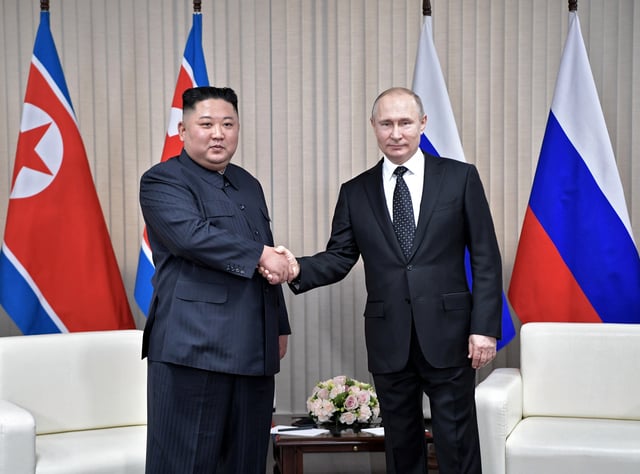
Kim and Russian President Vladimir Putin shake hands during of the North Korea–Russia Summit, April 2019
In his 2018 New Year Speech, Kim announced that he was open to dialogue with South Korea with a view to take part in the upcoming Winter Olympics in the South.[129] The Seoul–Pyongyang hotline was reopened after almost two years.[130] North and South Korea marched together in the Olympics opening ceremony, and fielded a united women's ice hockey team.[131] In addition to the athletes, Kim sent an unprecedented high-level delegation including his sister, Kim Yo-jong, and President of the Presidium, Kim Yong-nam, and performers such as the Samjiyon Orchestra.[132] On 5 March, he had a meeting with South Korea's Chief of the National Security Office, Chung Eui-yong, in Pyongyang.[133]
In March 2018, Kim visited Beijing, meeting with General Secretary of the Communist Party of China, Xi Jinping.[134][135][136]
At the April 2018 inter-Korean summit, Kim and South Korean President Moon Jae-in signed the Panmunjom Declaration, pledging to convert the Korean Armistice Agreement into a full peace treaty, formally ending the Korean War, by the end of the year.[137][138][139]
From 7–8 May, Kim made a second visit to China, meeting with Xi Jinping in Dalian.[140]
On 10 June, Kim arrived in Singapore and met with Prime Minister Lee Hsien Loong.[143]
On 12 June, Kim held his first summit with US President Donald Trump and signed a declaration, affirming a commitment to peace, nuclear disarmament, and the repatriation of the remains of U.S. war dead.[144]
In September, Kim held another summit with Moon Jae-in in Pyongyang. Kim agreed to dismantle North Korea's nuclear weapons facilities if the United States took reciprocal action. The two governments also announced that they would establish buffer zones on their borders to prevent clashes.[145]
In February 2019, Kim held another summit with US President Donald Trump in Hanoi, Vietnam, which Trump cut short on the second day without an agreement. The Trump administration said that the North Koreans wanted complete sanctions relief, while the North Koreans said that they were only asking for partial sanctions relief.[146]
On 25 April 2019, Kim held his first summit with Russian President Vladimir Putin in Vladivostok, Russia.[147][148]
On 30 June 2019, Kim again met with U.S.
President Donald Trump, shaking hands warmly and expressing hope for peace.
Kim and Trump then joined South Korea's President Moon Jae-in for a brief chat, marking an unprecedented three-way gathering.[149]
Personality
During Dennis Rodman's trip, Vice magazine correspondent Ryan Duffy said that "the leader was 'socially awkward' and didn't make eye contact when shaking hands".[155]
According to Cheong Seong-chang of the Sejong Institute, Kim Jong-un has greater visible interest in the welfare of his people and engages in greater interaction with them than his father did.[156]
South Koreans who saw Kim at the summit in April 2018 described him as straightforward, humorous, and attentive.[157] After meeting him, Donald Trump said, "I learned he was a talented man.
I also learned he loves his country very much."
He added that Kim had a "great personality" and was "very smart".[158]
Health
In 2009, reports suggested that Kim Jong-un was a diabetic and suffered from hypertension.[57][159] He is also known to smoke cigarettes.[160]
In September 2015, the South Korean government commented that Kim appeared to have gained 30 kg in body fat over the previous five years, reaching a total estimated body weight of 130 kg (290 lb).[163]
Family
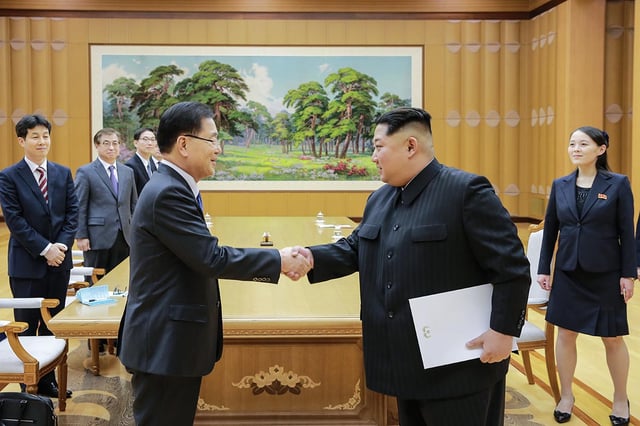
Kim (holding envelope) with Chung Eui-yong. Kim's sister Kim Yo-jong (on the right) is said to be very close to him
On 25 July 2012, North Korean state media reported for the first time that Kim Jong-un is married to Ri Sol-ju (리설주).[164][165] Ri, who was believed to be in her early 20s, had been accompanying Kim Jong-un to public appearances for several weeks prior to the announcement.[165] According to a South Korean analyst, Kim Jong-il had hastily arranged the marriage after suffering a stroke in 2008, the two married in 2009, and they had a child in 2010.[166] Dennis Rodman, after visiting in 2013, reported that they had a daughter named Kim Ju-ae.[167][168] However, South Korean sources speculated that they could have many children.[169]
Kim is sometimes accompanied by his younger sister Kim Yo-jong,[21][22] who is said to be instrumental in creating his public image and organising public events for him.[170] According to Kim Yong-hyun, a professor of North Korean studies at Dongguk University in Seoul, and others, the promotion of Kim Yo-jong and others is a sign that "the Kim Jong-un regime has ended its co-existence with the remnants of the previous Kim Jong-il regime by carrying out a generational replacement in the party's key elite posts".[171][172]
On 13 February 2017, Kim Jong-nam, the exiled half-brother of Kim Jong-un, was assassinated with the nerve agent VX while walking through Terminal 2 at Kuala Lumpur International Airport.[173]
See also
Inter-Korean summit
Kim dynasty (North Korea)
Kim Jong-un bibliography
Residences of North Korean leaders
Kim–Xi meetings
Kim–Putin meetings
2018 North Korea–United States Singapore Summit
2019 North Korea–United States Hanoi Summit
2019 Koreas–United States DMZ Summit
List of international trips made by Kim Jong-un
Jeongju Gim (Kim)